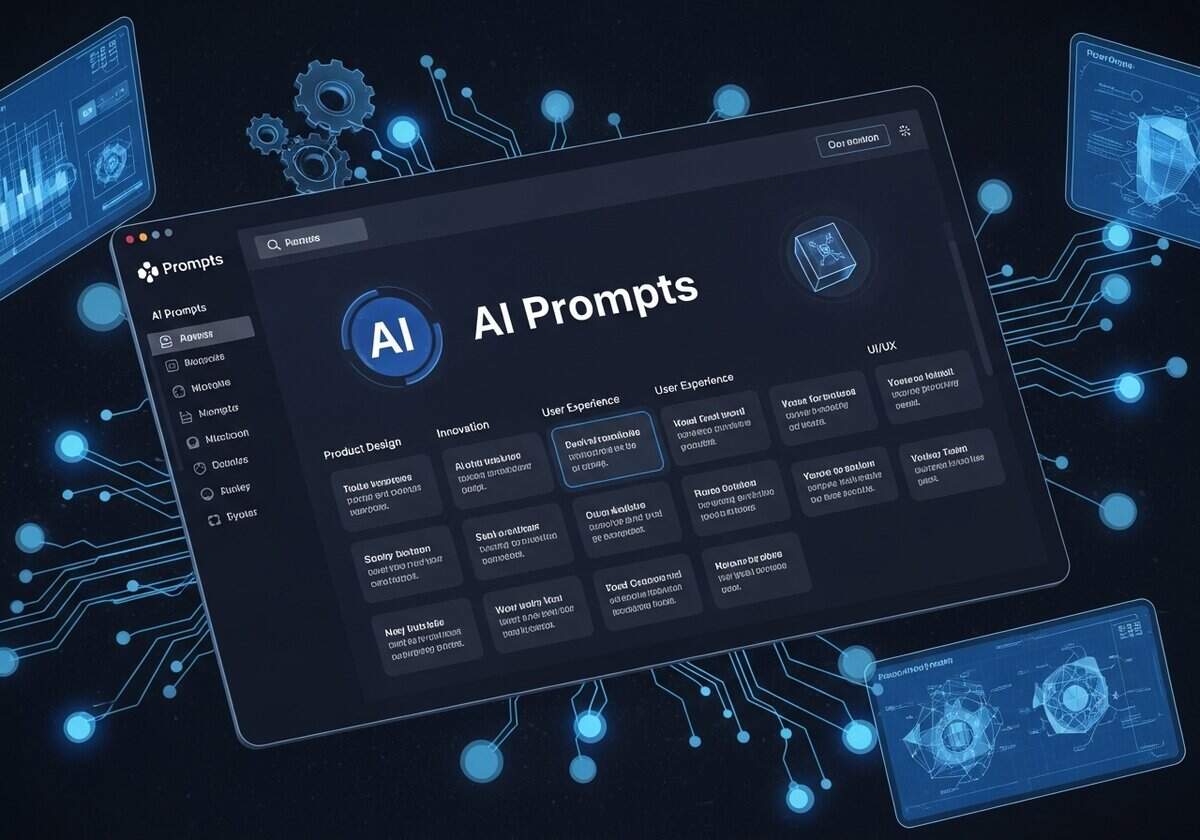Simplement le plus grand répertoire de prompts d'IA spécialisé en conception de produits et innovation

Bienvenue dans le plus grand répertoire mondial d'instructions d'IA dédié à la conception avancée de produits, à l'ingénierie, à la science, à l'innovation, à la qualité et à la fabrication. Si les outils d'IA en ligne transforment rapidement le paysage de l'ingénierie en augmentant les capacités humaines, leur véritable puissance est révélée par des instructions précises et élaborées par des experts. Ce répertoire complet vous fournit une collection de telles instructions, vous permettant de commander des systèmes d'IA capables de traiter de vastes quantités de données, d'identifier des modèles complexes et de générer des solutions inédites bien plus efficacement que les méthodes traditionnelles.
Découvrez et affinez les invites exactes nécessaires pour exploiter les agents d'IA en ligne afin d'optimiser vos conceptions pour des performances et une fabricabilité maximales, d'accélérer les simulations complexes, de prédire avec précision les propriétés des matériaux et d'automatiser une gamme variée de tâches analytiques critiques.
Les filtres de recherche avancés permettent un accès rapide à ce vaste répertoire et couvrent tout le spectre de l'ingénierie moderne.
Compte tenu des ressources et du temps disponibles sur le serveur, les invites elles-mêmes sont réservées aux membres enregistrés et ne sont pas visibles ci-dessous si vous n'êtes pas connecté. Vous pouvez vous inscrire, 100% gratuit :
Adhésion requise
Vous devez être membre du site pour accéder à ce contenu.
- Génération de code et débogage
Invitation à l'IA à MATLAB Script for 2D Truss FEA
- Analyse de la variance (ANOVA), Conception pour la fabrication (DfM), Optimisation de la conception, Ingénierie, Méthode des éléments finis (FEM), Science des matériaux, Génie mécanique, Simulation, Ingénierie des structures
Generates a basic MATLAB script to perform a Finite Element Analysis (FEA) on a 2D truss structure. The script will take nodal coordinates, element connectivity, material properties, loads, and boundary conditions as input.
Sortie :
- MATLAB
- ne nécessite pas d'Internet en direct
- Fields: {truss_geometry_and_properties_json} {load_and_boundary_conditions_json}
- Best for: Generating a foundational MATLAB script for 2D truss analysis, useful for educational purposes or as a starting point for custom FEA tools.
- Génération ou augmentation des données
Invitation à l'IA à Create Construction Schedule Variations
- Méthodologie Agile, Modélisation des données du bâtiment (BIM), Ingénierie de la construction, Production allégée, Gestion de projet, Analyse des risques, Gestion des risques
Generates multiple plausible variations of a construction schedule by introducing delays or accelerations to activities based on specified risk factors and their potential impacts. Helps in Monte Carlo simulations or risk analysis.
Sortie :
- CSV
- ne nécessite pas d'Internet en direct
- Fields: {baseline_schedule_csv_activities_durations_dependencies} {risk_event_descriptions_and_potential_impacts_on_duration} {number_of_scenario_variations}
- Best for: Generating data for schedule risk analysis, Monte Carlo simulations, and contingency planning.
- Extraction d'informations
Invitation à l'IA à Extract Material Properties from Text
- Fabrication additive, Matériaux composites, Composites, Conception pour la fabrication additive (DfAM), Matériels, Propriétés mécaniques, Conception de Produits, Développement de produits, Pratiques de durabilité
Extracts specified material properties for given materials from a block of unstructured text like a report or specification. This helps in quickly populating material databases or creating comparison sheets without manual searching.
Sortie :
- JSON
- ne nécessite pas d'Internet en direct
- Fields: {document_text} {list_of_materials_and_their_properties_to_find}
- Best for: Populating material databases or comparison sheets from unstructured text, saving manual effort.
- Génération ou augmentation des données
Invitation à l'IA à Create Synthetic Soil Bearing Capacity Data
- Génie civil, Ingénierie de la construction, Conception pour la durabilité, Optimisation de la conception, Évaluation de l'impact environnemental, Géotechnique, Science des matériaux, Contrôle de qualité, Ingénierie des structures
This prompt generates synthetic soil bearing capacity data based on input soil parameters {soil_properties_json}. The AI should produce a JSON array with multiple data points showing allowable bearing capacity values under varied depths and footing sizes for civil engineering foundation design.
Sortie :
- JSON
- ne nécessite pas d'Internet en direct
- Fields: {soil_properties_json}
- Best for: Best for creating varied soil bearing capacity datasets for foundation design.
- Extraction d'informations
Invitation à l'IA à Identify Key Structural Design Codes Cited
- Génie civil, Ingénierie de la construction, Analyse de la conception, Documentation de conception, Conception pour la fabrication (DfM), Conception pour la durabilité, Assurance qualité, Gestion de la qualité, Ingénierie des structures
This prompt scans through the provided civil engineering document text {document_text} to identify and list all references to structural design codes (e.g., ACI, Eurocode, IS codes), including version/year if available. The AI must list codes uniquely and give a brief description of their scope if known.
Sortie :
- Markdown
- ne nécessite pas d'Internet en direct
- Fields: {document_text}
- Best for: Best for extracting references to design standards from technical documents.
- Dépannage et diagnostic
Invitation à l'IA à Troubleshoot Heat Exchanger Efficiency Loss
- Corrosion, Efficacité, Traitement thermique, Détection des fuites, Maintenance, Amélioration des processus, Optimisation des processus, Contrôle de qualité, Gestion de la qualité
This prompt evaluates heat exchanger operational data and symptoms to diagnose causes of efficiency loss. The AI provides a markdown report outlining potential issues like fouling, leaks, or flow maldistribution with corrective recommendations.
Sortie :
- Markdown
- ne nécessite pas d'Internet en direct
- Fields: {heat_exchanger_data} {symptoms_description}
- Best for: Diagnose and address heat exchanger performance problems
- Dépannage et diagnostic
Invitation à l'IA à Troubleshoot Distillation Column Anomalies
- Recyclage des produits chimiques, Amélioration continue, Analyse des modes de défaillance et de leurs effets (AMDEC), Amélioration des processus, Optimisation des processus, Gestion de la qualité, Analyse des causes profondes, Contrôle statistique des processus (CSP)
This prompt takes detailed operational parameters and symptoms related to a distillation column and generates a structured diagnostic report identifying likely malfunctions, their causes, and recommended fixes.
Sortie :
- Markdown
- nécessite l'utilisation d'Internet en direct
- Fields: {operational_parameters} {symptoms}
- Best for: Identify and fix distillation column issues efficiently
- Dépannage et diagnostic
Invitation à l'IA à Diagnose Reactor Performance Issues
- Amélioration continue, Mesure corrective, Analyse des modes de défaillance et de leurs effets (AMDEC), Amélioration des processus, Optimisation des processus, Contrôle de qualité, Gestion de la qualité, Analyse des causes profondes, Contrôle statistique des processus (CSP)
This prompt helps diagnose common reactor performance problems by analyzing user-provided operational data and observed symptoms. The AI outputs a prioritized list of probable root causes along with suggested diagnostic tests or corrective actions.
Sortie :
- Markdown
- nécessite l'utilisation d'Internet en direct
- Fields: {operational_data} {symptoms_list}
- Best for: Systematic diagnosis of reactor malfunctions
- Génération d'hypothèses
Invitation à l'IA à Generate Hypotheses from Literature Summary
- Fabrication additive, Recyclage des produits chimiques, Amélioration continue, Évaluation de l'impact environnemental, Innovation, Optimisation des processus, Recherche et développement, Pratiques de durabilité, Développement durable
This prompt ingests a user-provided summary of recent literature on a chemical engineering topic and generates a list of potential hypotheses for further research, highlighting gaps or inconsistencies discovered. The output is a JSON array with hypothesis statements and supporting notes.
Sortie :
- JSON
- ne nécessite pas d'Internet en direct
- Fields: {literature_summary}
- Best for: Discover new research directions from literature analysis
- Génération d'hypothèses
Invitation à l'IA à Suggest Novel Process Optimization Hypotheses
- Amélioration continue, Conception pour la durabilité, Efficacité, Innovation, Production allégée, Amélioration des processus, Optimisation des processus, Gestion de la qualité, Pratiques de durabilité
This prompt takes a brief description of a chemical process and suggests innovative, testable process optimization hypotheses that could improve efficiency, yield, or sustainability. The output is a markdown report detailing each hypothesis with rationale and expected benefits.
Sortie :
- Markdown
- ne nécessite pas d'Internet en direct
- Fields: {process_description}
- Best for: Generate innovative ideas for process improvement































Personne n'a discuté de la partialité potentielle de la sélection de l'IA pour ces annuaires ? L'IA n'est pas à l'abri des préjugés.